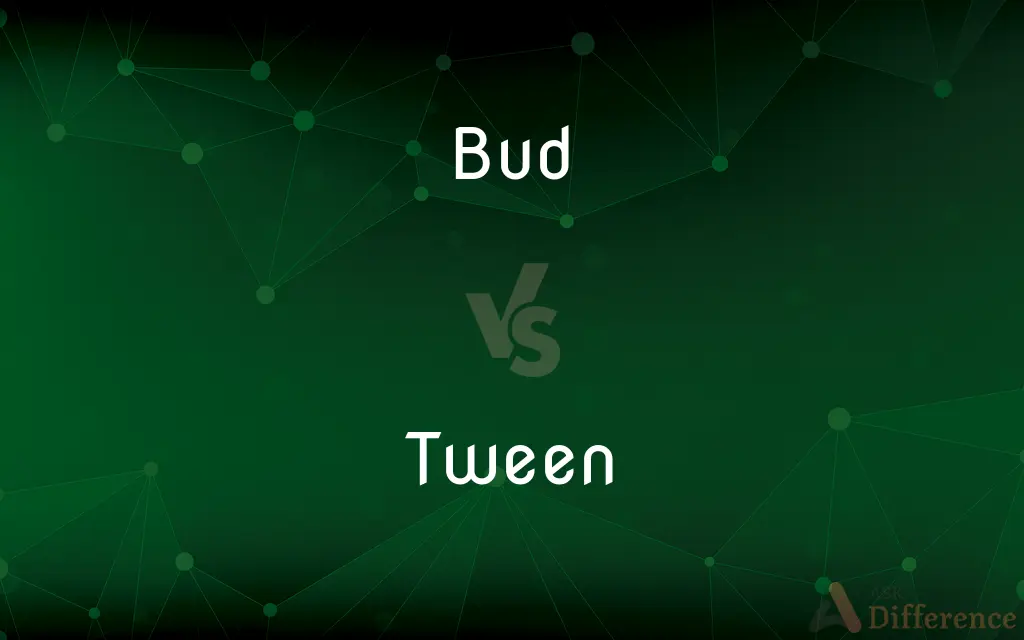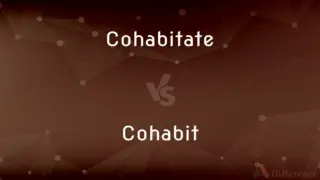Bud vs. Tween — What's the Difference?
Edited by Tayyaba Rehman — By Urooj Arif — Updated on April 20, 2024
Bud refers to a plant's early stage of development, typically encapsulated and embryonic, while Tween, often Tween 20 or Tween 80, is a synthetic compound used in biochemistry and pharmacology.

Difference Between Bud and Tween
Table of Contents
ADVERTISEMENT
Key Differences
A bud is an undeveloped or embryonic shoot and usually appears from a growth point on the stem or limb of a plant. Whereas Tween, specifically Tween 20 and Tween 80, are types of nonionic surfactants used in the formulation of emulsions, medicinal products, and food preparations.
Buds are natural parts of a plant's reproductive and growth processes, functioning as the initial form of leaves, flowers, or shoots. On the other hand, Tween compounds are synthetically produced and serve as agents to stabilize and improve the mixing of substances in various industrial and research applications.
In gardening and horticulture, the health and appearance of buds can be crucial indicators of plant health and the upcoming bloom quality. In contrast, the use of Tween in laboratories and industries focuses on its effectiveness as a solubilizing agent, helping mix ingredients that typically do not combine well.
Bud development is influenced by environmental conditions such as temperature, light, and water availability. Conversely, the effectiveness of Tween depends on its chemical composition, concentration, and the properties of the materials it is mixed with.
Buds undergo a natural growth cycle, culminating in flowering or leafing, which is essential for plant reproduction and growth. Whereas Tween's role is primarily functional within manufactured products, affecting neither growth nor reproduction.
ADVERTISEMENT
Comparison Chart
Definition
An embryonic part of a plant
A synthetic nonionic surfactant
Usage
Plant growth and reproduction
Industrial and laboratory applications
Natural vs. Synthetic
Natural
Synthetic
Environmental Influence
Yes (temperature, light, water)
No
Role in Lifecycle
Developmental (growth, flowering)
Functional (stabilizing, mixing)
Compare with Definitions
Bud
A compact growth on a plant that develops into a leaf, flower, or shoot.
The cherry tree's buds swell in early spring.
Tween
Used in cosmetics to stabilize ingredients and ensure texture consistency.
Tween is often listed in the ingredients of lotion.
Bud
The stage in some animals, like hydra, where a new individual starts to develop from another.
Hydras reproduce by budding.
Tween
Acts as a solubilizing agent in food products.
Ice cream manufacturers use Tween to improve texture.
Bud
To start to develop or grow.
Her interest in music began to bud in childhood.
Tween
Important in scientific research for preparing mixtures of materials.
Tween solutions are used for cell culture experiments.
Bud
A small outgrowth from a fungus cap, typically representing a nascent growth.
Mushroom buds appear overnight in moist soil.
Tween
A term used for Tween 20 or Tween 80, common emulsifiers in biochemical applications.
Tween 80 is used to enhance medication absorption.
Bud
In botany, a bud is an undeveloped or embryonic shoot and normally occurs in the axil of a leaf or at the tip of a stem. Once formed, a bud may remain for some time in a dormant condition, or it may form a shoot immediately.
Tween
Utilized in the pharmaceutical industry as a dispersing agent.
Tween aids in the formulation of injectable drugs.
Bud
A small protuberance on a stem or branch, sometimes enclosed in protective scales and containing an undeveloped leaf, flower, or leafy shoot.
Tween
Between.
Bud
The stage or condition of having buds
Branches in full bud.
Tween
A child between middle childhood and adolescence, usually between 8 and 12 years old. Also called tweener.
Bud
Flowers from a female cannabis plant, especially after being harvested and prepared for smoking or other use
Bought some bud.
Tween
(animation) An action of tweening (inserting frames for continuity); a sequence of frames generated by tweening.
Bud
A single flower of a cannabis plant, especially a female flower
When to harvest buds.
Tween
A child, especially a girl, in the age range between middle childhood and adolescence, normally between eight and thirteen years of age.
Bud
A small, rounded organic part, such as a taste bud, that resembles a plant bud.
Tween
(cinematography) To generate intermediate frames in an animated sequence so as to give the appearance of smooth movement.
Bud
One that is not yet fully developed
The bud of a new idea.
Tween
Of or having to do with tweenagers.
Bud
An earbud.
Bud
Friend; chum. Used as a form of familiar address, especially for a man or boy
Move along, bud.
Bud
To put forth or produce buds
A plant that buds in early spring.
Bud
To develop or grow from or as if from a bud
"listened sympathetically for a moment, a bemused smile budding forth" (Washington Post).
Bud
To be in an undeveloped stage or condition.
Bud
To cause to put forth buds.
Bud
To graft a bud onto (a plant).
Bud
A newly sprouted leaf or blossom that has not yet unfolded.
After a long, cold winter, the trees finally began to produce buds.
Bud
A small rounded body in the process of splitting from an organism, which may grow into a genetically identical new organism.
In this slide, you can see a yeast cell forming buds.
Bud
Potent cannabis taken from the flowering part of the plant (the "bud"), or marijuana generally.
Hey bro, want to smoke some bud?
Bud
A weaned calf in its first year, so called because the horns are then beginning to bud.
Bud
A pretty young girl.
Bud
Buddy, friend.
I like to hang out with my buds on Saturday night.
Bud
Used to address a male
Bud
(intransitive) To form buds.
The trees are finally starting to bud.
Bud
(intransitive) To reproduce by splitting off buds.
Yeast reproduces by budding.
Bud
(intransitive) To begin to grow, or to issue from a stock in the manner of a bud, as a horn.
Bud
(intransitive) To be like a bud in respect to youth and freshness, or growth and promise.
Bud
(transitive) To put forth as a bud.
Bud
(transitive) To graft by inserting a bud under the bark of another tree.
Bud
A small protuberance on the stem or branches of a plant, containing the rudiments of future leaves, flowers, or stems; an undeveloped branch or flower.
Bud
A small protuberance on certain low forms of animals and vegetables which develops into a new organism, either free or attached. See Hydra.
Bud
To put forth or produce buds, as a plant; to grow, as a bud does, into a flower or shoot.
Bud
To begin to grow, or to issue from a stock in the manner of a bud, as a horn.
Bud
To be like a bud in respect to youth and freshness, or growth and promise; as, a budding virgin.
Bud
To graft, as a plant with another or into another, by inserting a bud from the one into an opening in the bark of the other, in order to raise, upon the budded stock, fruit different from that which it would naturally bear.
The apricot and the nectarine may be, and usually are, budded upon the peach; the plum and the peach are budded on each other.
Bud
A partially opened flower
Bud
A swelling on a plant stem consisting of overlapping immature leaves or petals
Bud
Develop buds;
The hibiscus is budding!
Bud
Start to grow or develop;
A budding friendship
Common Curiosities
How does the environment affect bud growth?
Environmental factors like light, temperature, and water availability significantly influence bud growth and development.
Are there environmental concerns associated with Tween usage?
While generally safe, the environmental impact of synthetic surfactants like Tween can include potential pollution if not managed properly.
What are common types of Tween?
Common types of Tween include Tween 20 and Tween 80, both used as emulsifiers and solubilizers.
What is a bud in botany?
In botany, a bud is a small axial growth on a plant that can develop into a new leaf, flower, or stem.
What is the primary use of Tween in industries?
Tween is primarily used to stabilize emulsions in pharmaceuticals, cosmetics, and food products.
What distinguishes bud development in plants from animals?
In plants, buds are involved in developing new plant structures, while in animals, similar processes involve different mechanisms like regeneration or embryonic development.
How do Twill and buds interact in biological research?
In biological research, Tween can be used to prepare samples that include plant buds for microscopic examination.
How does seasonal change affect bud development?
Seasonal changes can trigger buds to enter a dormant state or to begin growth, depending on the plant species and local climate.
What is the significance of bud position on plant health?
The position and condition of buds on a plant can indicate overall plant health and potential for future growth.
How does a bud develop?
A bud develops from a meristem, which is a region of rapid cell division in plants.
Can the use of Tween affect human health?
When used within recommended guidelines, Tween is considered safe, though excessive use can lead to issues like allergies in sensitive individuals.
Is Tween safe for use in food products?
Yes, Tween is generally recognized as safe for use in food products within regulated limits.
What are the safety standards for using Tween in pharmaceuticals?
The use of Tween in pharmaceuticals must meet strict regulatory standards to ensure safety and efficacy.
What factors affect the choice of Tween type in manufacturing?
Factors include the specific application, desired solubility, and the chemical properties of other ingredients.
Can buds appear on all parts of a plant?
Buds typically appear on stems and near leaf axils, but they can also form on roots in some species.
Share Your Discovery

Previous Comparison
Dieting vs. Fasting
Next Comparison
Cohabitate vs. CohabitAuthor Spotlight
Written by
Urooj ArifUrooj is a skilled content writer at Ask Difference, known for her exceptional ability to simplify complex topics into engaging and informative content. With a passion for research and a flair for clear, concise writing, she consistently delivers articles that resonate with our diverse audience.
Edited by
Tayyaba RehmanTayyaba Rehman is a distinguished writer, currently serving as a primary contributor to askdifference.com. As a researcher in semantics and etymology, Tayyaba's passion for the complexity of languages and their distinctions has found a perfect home on the platform. Tayyaba delves into the intricacies of language, distinguishing between commonly confused words and phrases, thereby providing clarity for readers worldwide.
















































